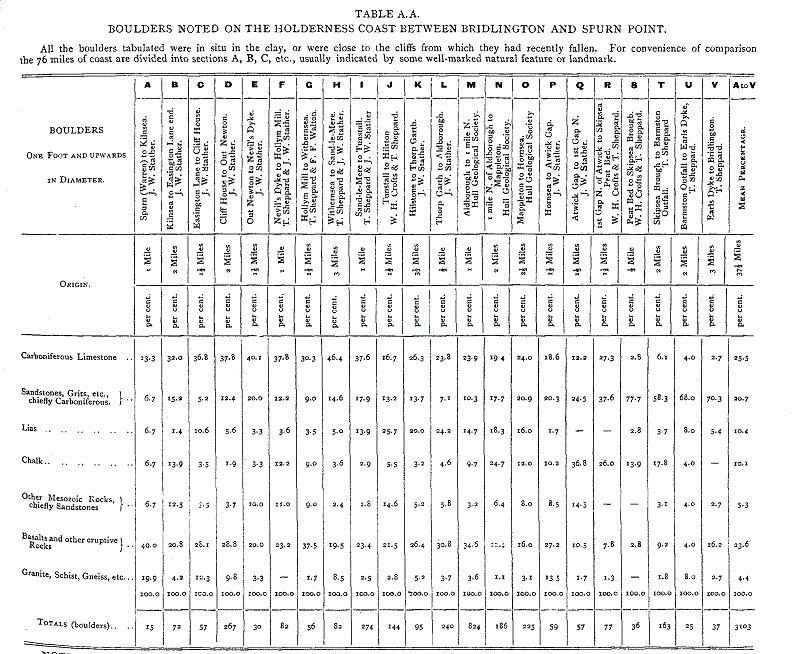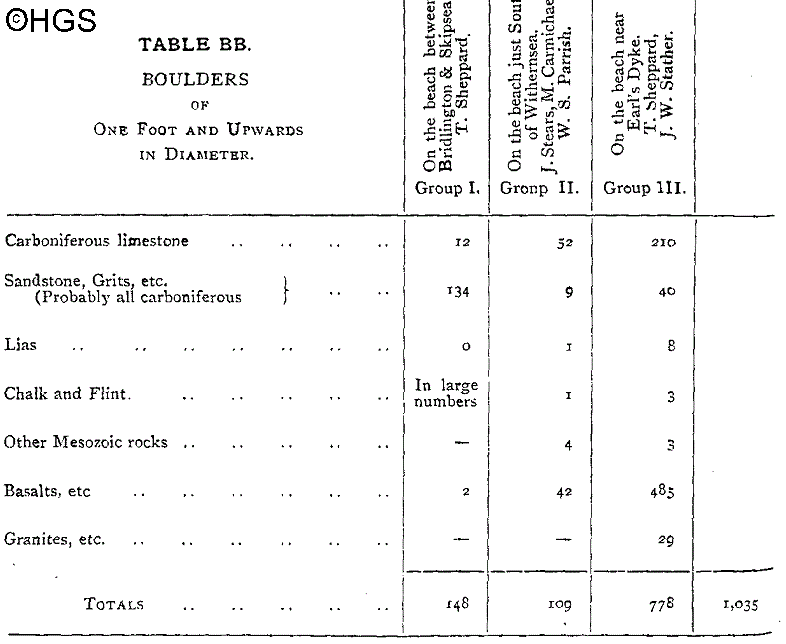
TRANSACTIONS
OF THE
HULL
GEOLOGICAL
SOCIETY
Incomplete
REPORT OF THE EAST RIDING BOULDER COMMITTEE. SEPTEMBER 1st 1896.
The Committee since the
presentation of the last report, have noted upwards of 2,600 boulders,
chiefly in Holderness.
TABLF, AA.--Gives the
results of the systematic survey of boulders
in situ in the cliffs of
Holderness between Spurn and Bridlington.
TABLE BB.--Gives an
analysis of three representative beach groups.
TABLE CC
(not scanned) --Refers to Red Cliff (N.
Ferriby), and is similar to AA.
TABLE DD
(not scanned)--Refers to Redcar and Saltburn,
and is similar to AA.
The remainder of the
report consists of notes of inland erratics,

TABLE A.A. BOULDERS NOTED ON THE HOLDERNESS COAST BETWEEN BRIDLINGTON
AND SPURN POINT. All the boulders tabulated were
in situ in the clay, or were close to the cliffs from which they had
recently fallen. For convenience of comparison the 76 miles of coast are
divided into sections A, B, C, etc., usually indicated by some well-marked
natural feature or landmark.
NOTES (TABLE A.A).--In
section A and B several small boulders of Augite syenite (Lausvikete of
Brogger) were observed sticking in the clay; while 2 blocks (each 15 inches
in diameter) and 30 smaller boulders of the same rock occurred on the shore.
In section D. a boulder
of Shap occurs on the beach, along with a fine sample of Augite syenite, 2
feet in diameter.
Sections P. and
Q.--Many crushed-out chalk boulders in the cliff. .4. boulder of Augite
syenite on the shore (e ft. by ½ ft. by ft.), and several smaller specimens.
Here also Rhomb porphyry was found in
situ in the cliff.
The relative scarcity
of the harder rocks in some of the sections north of Hornsea is due in part,
at any rate to the efforts of the local road menders.

TABLE B.B.
Three typical groups of boulders on
the beach of the Holderness coast, illustrating the Selective and Arranging
power of the waves.
Reported by Mr. J. W.
STATHER.
NORTH FERRIBY. In the
boulder clay cliff on the Humber shore near North Ferriby,
feet above sea-level.
None of the boulders noted show striations and all have been moved; but
probably only from the adjacent fields.
1. A block of andesitic
tuff, near the pinfold 48” x 28” × 30”.
2. A rounded block of
red granite (not Shap) at corner of Ferriby Road 28” x 24” x 18".
3. A block of Whinstone
(basalt), near Mr. Carr's house, used as a seat. 52” x 36”×24".
4 A gritty sandstone at
the west end of the village. 41” x 32” x 27".
5. Also several more
boulders of Whinstone (smaller than above) near the pond, and a sandstone
24” x 18” × 18".
Reported by Mr. F, F.
WALTON, F. G. S,
Coniston (Holderness).
At road-side, near the pond, north of the village is a boulder of fine-
grained white granite, somewhat rounded and weathered reddish, 33” by 27” by
15".
Skirlaugh. On roadside,
outside ' Carpenters' Arms,' a boulder of basalt, 18” by 15” by 15". At
gateway, opposite above, a rounded basalt, 17” by 15” by 12".
Preston (in Holderness).
The footpaths on each side of main street are paved with boulders from 2 ft.
in diameter downwards. About three out of every four are basalts, the
remainder mostly Carboniferous sandstones.
There is a group of four
boulders at north end of village at corner of Sproatley Road, as follows:-
No. 1.--Basalt
irregular, oblong, and flat on one side, 60” by 30” by 24”
No. 2.--Basalt, rounded,
28” by 17” by 16".
No. 3.--Basalt, rounded,
25” by 20” by 20".
No. 4--Dolerite (?), 27”
by 20” by 20".
Also at corner of
Burstwick Road there are two basalts, each about 2 ft. in diameter.
Reported by Mr. W. H.
CROFTS.
ATWICK. A boulder of
Shap Granite, near the old village cross, 12” by 9” by 9".
Reported by Mr. JNO.
NICHOLSON.
HORNSEA. A group of
boulders in Harker's Yard (near the old Cross), as follows :--
1. Carboniferous
limestone (?). Is well-rounded, but has one side as flat as a table. 48” by
24” by 4".
2. Basalt. 48 by 30 by
18".
3. Carboniferous
Limestone. 24” by 18” by 18”.
4. Basalt. 18” by 12” by
10".
HORNSEA. At south end of
the old village, at junction of the Hull Road with the main street, a
boulder of dolerite 57” by 42” by 18".
FLINTON. A sandstone
boulder 30” by 24” by 21”
[Note -This article has been scanned in from original printed format and then put through an OCR program by Mike Horne. The process may have introduced some new spelling errors to the texts. Some original misspellings have been corrected.]
Copyright Hull Geological Society 2020
